Improving the Performance of Feather Keratin/Polyvinyl Alcohol/Tris(hydroxymethyl)Aminomethane Nanocomposite Films by Incorporating Graphene Oxide or Graphene
Abstract
1. Introduction
2. Materials and Methods
2.1. Materials
2.2. Preparation of 0.5% GO Dispersion
2.3. Preparation of the Nanocomposite Films
2.4. Characterization
3. Results and Discussion
3.1. Morphology of the Nanocomposite Films
3.2. FTIR Analysis
3.3. TGA
3.4. Mechanical Properties
3.5. TSM Results for the Blend Films
3.6. Barrier Properties of the Blend Films
3.6.1. WVP
3.6.2. OP
3.6.3. Light Transmission and Transparency
4. Conclusions
Author Contributions
Funding
Acknowledgments
Conflicts of Interest
References
- Ramirez, D.O.S.; Carletto, R.A.; Tonetti, C.; Giachet, F.T.; Varesano, A.; Vineis, C. Wool keratin film plasticized by citric acid for food packaging. Food Packag. Shelf Life 2017, 12, 100–106. [Google Scholar] [CrossRef]
- Ramakrishnan, N.; Sharma, S.; Gupta, A.; Alashwal, B.Y. Keratin based bioplastic film from chicken feathers and its characterization. Int. J. Biol. Macromol. 2018, 111, 352–358. [Google Scholar] [CrossRef] [PubMed]
- Sharma, S.; Gupta, A.; Kumar, A.; Kee, C.G.; Kamyab, H.; Saufi, S.M. An efficient conversion of waste feather keratin into ecofriendly bioplastic film. Clean Technol. Environ. Policy 2018, 20, 2157–2167. [Google Scholar] [CrossRef]
- Zhang, Y.Q. Dissociation and Extraction of Feather Keratin by Steam Flash Explosion. Ph.D. Thesis, Jiangnan University, Wuxi, China, 2016. [Google Scholar]
- Shui-qing, J.; Lin, Z.; Haixia, W.; Gang, C. Study on effective extraction of keratin from human hair wastes. Integr. Ferroelectr. 2017, 180, 102–107. [Google Scholar] [CrossRef]
- Shavandi, A.; Bekhit, A.E.-D.A.; Carne, A.; Bekhit, A. Evaluation of keratin extraction from wool by chemical methods for bio-polymer application. J. Bioact. Compat. Polym. 2016, 32, 163–177. [Google Scholar] [CrossRef]
- Kang, D.; Herschend, J.; Al-Soud, W.A.; Mortensen, M.S.; Gonzalo, M.; Jacquiod, S.; Sørensen, S.J. Enrichment and characterization of an environmental microbial consortium displaying efficient keratinolytic activity. Bioresour. Technol. 2018, 270, 303–310. [Google Scholar] [CrossRef]
- Sekar, V.; Kannan, M.; Ganesan, R.; Dheeba, B.; Sivakumar, N.; Kannan, K. Isolation and screening of keratinolytic bacteria from feather dumping soil in and around cuddalore and villupuram, tamil nadu. Proc. Natl. Acad. Sci. India 2015, 86, 1–9. [Google Scholar] [CrossRef]
- Chen, X.; Wu, S.; Yi, M.; Ge, J.; Yin, G.; Li, X. Preparation and physicochemical properties of blend films of feather keratin and poly(vinyl alcohol) compatibilized by tris(hydroxymethyl)aminomethane. Polymers 2018, 10, 1054–1065. [Google Scholar] [CrossRef]
- Wu, S.; Chen, X.; Yi, M.; Ge, J.; Yin, G.; Li, X. Improving the water resistance and mechanical properties of feather keratin/polyvinyl alcohol/tris (hydroxymethyl) aminomethane blend films by cross-linking with transglutaminase, cacl2, and genipin. Materials 2018, 11, 2203–2216. [Google Scholar] [CrossRef]
- Liu, D.; Zhang, Y.; Sun, X.; Chang, P.R. Recent advances in bio-sourced polymeric carbohydrate/nanotube composites. J. Appl. Polym. Sci. 2014, 131, 40359–40371. [Google Scholar] [CrossRef]
- El Achaby, M.; Qaiss, A. Processing and properties of polyethylene reinforced by graphene nanosheets and carbon nanotubes. Mater. Des. 2013, 44, 81–89. [Google Scholar] [CrossRef]
- Wu, S.; Chen, X.; Yi, M.; Ge, J.; Yin, G.; Li, X.; He, M. Improving thermal, mechanical, and barrier properties of feather keratin/polyvinyl alcohol/tris (hydroxymethyl) aminomethane nanocomposite films by incorporating sodium montmorillonite and tio2. Nanomaterials 2019, 9, 298–314. [Google Scholar] [CrossRef] [PubMed]
- Bao, C.; Guo, Y.; Song, L.; Hu, Y. Poly (vinyl alcohol) nanocomposites based on graphene and graphite oxide: A comparative investigation of property and mechanism. J. Mater. Chem. 2011, 21, 13942–13950. [Google Scholar] [CrossRef]
- Novoselov, K.S.; Geim, A.K.; Morozov, S.V.; Jiang, D.; Zhang, Y.; Dubonos, S.V.; Grigorieva, I.V.; Firsov, A.A. Electric field effect in atomically thin carbon films. Science 2004, 306, 666–669. [Google Scholar] [CrossRef] [PubMed]
- Novoselov, K.S.; Geim, A. The rise of graphene. Nat. Mater. 2007, 6, 183–191. [Google Scholar]
- Ramanathan, T.; Abdala, A.; Stankovich, S.; Dikin, D.; Herrera-Alonso, M.; Piner, R.D.; Adamson, D.; Schniepp, H.; Chen, X.; Ruoff, R. Functionalized graphene sheets for polymer nanocomposites. Nat. Nanotechnol. 2008, 3, 327–331. [Google Scholar] [CrossRef]
- Ashori, A.; Bahrami, R. Modification of physico-mechanical properties of chitosan-tapioca starch blend films using nano graphene. Polym. Plast. Technol. Eng. 2014, 53, 312–318. [Google Scholar] [CrossRef]
- Hu, X.; Yu, Y.; Zhou, J.; Wang, Y.; Liang, J.; Zhang, X.; Chang, Q.; Song, L. The improved oil/water separation performance of graphene oxide modified al2o3 microfiltration membrane. J. Membr. Sci. 2015, 476, 200–204. [Google Scholar] [CrossRef]
- Stankovich, S.; Dikin, D.A.; Piner, R.D.; Kohlhaas, K.A.; Kleinhammes, A.; Jia, Y.; Wu, Y.; Nguyen, S.T.; Ruoff, R.S. Synthesis of graphene-based nanosheets via chemical reduction of exfoliated graphite oxide. Carbon 2007, 45, 1558–1565. [Google Scholar] [CrossRef]
- Schniepp, H.C.; Li, J.-L.; McAllister, M.J.; Sai, H.; Herrera-Alonso, M.; Adamson, D.H.; Prud’homme, R.K.; Car, R.; Saville, D.A.; Aksay, I.A. Functionalized single graphene sheets derived from splitting graphite oxide. J. Phys. Chem. B 2006, 110, 8535–8539. [Google Scholar] [CrossRef]
- Ahmed, J.; Mulla, M.; Arfat, Y.A. Mechanical, thermal, structural and barrier properties of crab shell chitosan/graphene oxide composite films. Food Hydrocoll. 2017, 71, 141–148. [Google Scholar] [CrossRef]
- Yadav, M.; Rhee, K.Y.; Park, S. Synthesis and characterization of graphene oxide/carboxymethylcellulose/alginate composite blend films. Carbohydr. Polym. 2014, 110, 18–25. [Google Scholar] [CrossRef] [PubMed]
- Hummers, W.S., Jr.; Offeman, R.E. Preparation of graphitic oxide. J. Am. Chem. Soc. 1958, 80, 1339. [Google Scholar] [CrossRef]
- Dou, Y.; Zhang, B.; He, M.; Yin, G.; Cui, Y.; Savina, I.N. Keratin/polyvinyl alcohol blend films cross-linked by dialdehyde starch and their potential application for drug release. Polymers 2015, 7, 580–591. [Google Scholar] [CrossRef]
- He, M.; Zhang, B.; Dou, Y.; Yin, G.; Cui, Y. Blend modification of feather keratin-based films using sodium alginate. J. Appl. Polym. Sci. 2017, 134, 44680–44687. [Google Scholar] [CrossRef]
- Kumar, S.; Koh, J. Physiochemical and optical properties of chitosan based graphene oxide bionanocomposite. Int. J. Biol. Macromol. 2014, 70, 559–564. [Google Scholar] [CrossRef]
- Zeng, Y.; Zhou, Y.; Zhou, T.; Shi, G. A novel composite of reduced graphene oxide and molecularly imprinted polymer for electrochemical sensing 4-nitrophenol. Electrochim. Acta 2014, 130, 504–511. [Google Scholar] [CrossRef]
- El Achaby, M.; Essamlali, Y.; El Miri, N.; Snik, A.; Abdelouahdi, K.; Fihri, A.; Zahouily, M.; Solhy, A. Graphene oxide reinforced chitosan/polyvinylpyrrolidone polymer bio-nanocomposites. J. Appl. Polym. Sci. 2014, 131, 41042–41052. [Google Scholar] [CrossRef]
- Eslami, H.; Behrouz, M. Molecular dynamics simulation of a polyamide-66/carbon nanotube nanocomposite. J. Phys. Chem. C 2014, 118, 9841–9851. [Google Scholar] [CrossRef]
- Eslami, H.; Muller-Plathe, F. Structure and mobility of nanoconfined polyamide-6, 6 oligomers: Application of a molecular dynamics technique with constant temperature, surface area, and parallel pressure. J. Phys. Chem. B 2009, 113, 5568–5581. [Google Scholar] [CrossRef]
- Wang, W.; Wang, K.; Xiao, J.; Liu, Y.; Zhao, Y.; Liu, A. Performance of high amylose starch-composited gelatin films influenced by gelatinization and concentration. Int. J. Biol. Macromol. 2017, 94, 258–265. [Google Scholar] [CrossRef]
- Ahmad, M.; Hani, N.M.; Nirmal, N.P.; Fazial, F.F.; Mohtar, N.F.; Romli, S.R. Optical and thermo-mechanical properties of composite films based on fish gelatin/rice flour fabricated by casting technique. Prog. Org. Coat. 2015, 84, 115–127. [Google Scholar] [CrossRef]
- De Silva, R.T.; Mantilaka, M.; Ratnayake, S.P.; Amaratunga, G.A.J.; de Silva, K.M.N. Nano-mgo reinforced chitosan nanocomposites for high performance packaging applications with improved mechanical, thermal and barrier properties. Carbohydr. Polym. 2017, 157, 739–747. [Google Scholar] [CrossRef]
- Bindu Sharmila, T.K.; Ayswarya, E.P.; Abraham, B.T.; Sabura Begum, P.M.; Thachil, E.T. Fabrication of partially exfoliated and disordered intercalated cloisite epoxy nanocomposites via in situ polymerization: Mechanical, dynamic mechanical, thermal and barrier properties. Appl. Clay Sci. 2014, 102, 220–230. [Google Scholar] [CrossRef]
- Xu, Y.; Hong, W.; Bai, H.; Li, C.; Shi, G. Strong and ductile poly (vinyl alcohol)/graphene oxide composite films with a layered structure. Carbon 2009, 47, 3538–3543. [Google Scholar] [CrossRef]
- Nagarajan, M.; Benjakul, S.; Prodpran, T.; Songtipya, P. Characteristics of bio-nanocomposite films from tilapia skin gelatin incorporated with hydrophilic and hydrophobic nanoclays. J. Food Eng. 2014, 143, 195–204. [Google Scholar] [CrossRef]
- Yang, X.; Tu, Y.; Li, L.; Shang, S.; Tao, X.-M. Well-dispersed chitosan/graphene oxide nanocomposites. ACS Appl. Mater. Interfaces 2010, 2, 1707–1713. [Google Scholar] [CrossRef]
- Pandele, A.M.; Ionita, M.; Crica, L.; Dinescu, S.; Costache, M.; Iovu, H. Synthesis, characterization, and in vitro studies of graphene oxide/chitosan–polyvinyl alcohol films. Carbohydr. Polym. 2014, 102, 813–820. [Google Scholar] [CrossRef]
- Tan, B.; Thomas, N.L. A review of the water barrier properties of polymer/clay and polymerigraphene nanocomposites. J. Membr. Sci. 2016, 514, 595–612. [Google Scholar] [CrossRef]
- Svagan, A.J.; Åkesson, A.; Cárdenas, M.; Bulut, S.; Knudsen, J.C.; Risbo, J.; Plackett, D. Transparent films based on pla and montmorillonite with tunable oxygen barrier properties. Biomacromolecules 2012, 13, 397–405. [Google Scholar] [CrossRef]
- Uysal Unalan, I.; Boyacı, D.; Ghaani, M.; Trabattoni, S.; Farris, S. Graphene oxide bionanocomposite coatings with high oxygen barrier properties. Nanomaterials 2016, 6, 244–253. [Google Scholar] [CrossRef] [PubMed]
- Müller, C.M.; Yamashita, F.; Laurindo, J.B. Evaluation of the effects of glycerol and sorbitol concentration and water activity on the water barrier properties of cassava starch films through a solubility approach. Carbohydr. Polym. 2008, 72, 82–87. [Google Scholar] [CrossRef]
- Huang, H.-D.; Ren, P.-G.; Xu, J.-Z.; Xu, L.; Zhong, G.-J.; Hsiao, B.S.; Li, Z.-M. Improved barrier properties of poly (lactic acid) with randomly dispersed graphene oxide nanosheets. J. Membr. Sci. 2014, 464, 110–118. [Google Scholar] [CrossRef]
- Thomas, N.L. The barrier properties of paint coatings. Prog. Org. Coat. 1991, 19, 101–121. [Google Scholar] [CrossRef]
- El-Rehim, H.A.; Kamal, H.; Hegazy, E.-S.A.; Soliman, E.-S.; Sayed, A. Use of gamma rays to improve the mechanical and barrier properties of biodegradable cellulose acetate nanocomposite films. Radiat. Phys. Chem. 2018, 153, 180–187. [Google Scholar] [CrossRef]
- El Achaby, M.; Arrakhiz, F.; Vaudreuil, S.; Essassi, E.; Qaiss, A. Piezoelectric β-polymorph formation and properties enhancement in graphene oxide–pvdf nanocomposite films. Appl. Surf. Sci. 2012, 258, 7668–7677. [Google Scholar] [CrossRef]
- Compton, O.C.; Kim, S.; Pierre, C.; Torkelson, J.M.; Nguyen, S.T. Crumpled graphene nanosheets as highly effective barrier property enhancers. Adv. Mater. 2010, 22, 4759–4763. [Google Scholar] [CrossRef]
- Mahmoudi, N.; Ostadhossein, F.; Simchi, A. Physicochemical and antibacterial properties of chitosan-polyvinylpyrrolidone films containing self-organized graphene oxide nanolayers. J. Appl. Polym. Sci. 2016, 133, 43194–43201. [Google Scholar] [CrossRef]
- Farahnaky, A.; Dadfar, S.M.M.; Shahbazi, M. Physical and mechanical properties of gelatin–clay nanocomposite. J. Food Eng. 2014, 122, 78–83. [Google Scholar] [CrossRef]
- Hoque, M.S.; Benjakul, S.; Prodpran, T.; Songtipya, P. Properties of blend film based on cuttlefish (sepia pharaonis) skin gelatin and mungbean protein isolate. Int. J. Biol. Macromol. 2011, 49, 663–673. [Google Scholar] [CrossRef]
- Martucci, J.F.; Ruseckaite, R.A. Biodegradable bovine gelatin/na+-montmorillonite nanocomposite films. Structure, barrier and dynamic mechanical properties. Polym. Plast. Technol. Eng. 2010, 49, 581–588. [Google Scholar] [CrossRef]
- Nagarajan, M.; Benjakul, S.; Prodpran, T.; Songtipya, P. Properties of film from splendid squid (loligo formosana) skin gelatin with various extraction temperatures. Int. J. Biol. Macromol. 2012, 51, 489–496. [Google Scholar] [CrossRef] [PubMed]
- Tongnuanchan, P.; Benjakul, S.; Prodpran, T. Physico-chemical properties, morphology and antioxidant activity of film from fish skin gelatin incorporated with root essential oils. J. Food Eng. 2013, 117, 350–360. [Google Scholar] [CrossRef]
- Martucci, J.; Ruseckaite, R. Structure and properties of gelatin/montomorillonite nanocomposite films. In Recent Advances in Research on Biodegradable Polymers and Sustainable Polymers; Nova Publishers: Huntington, WV, USA, 2008; pp. 27–36. [Google Scholar]
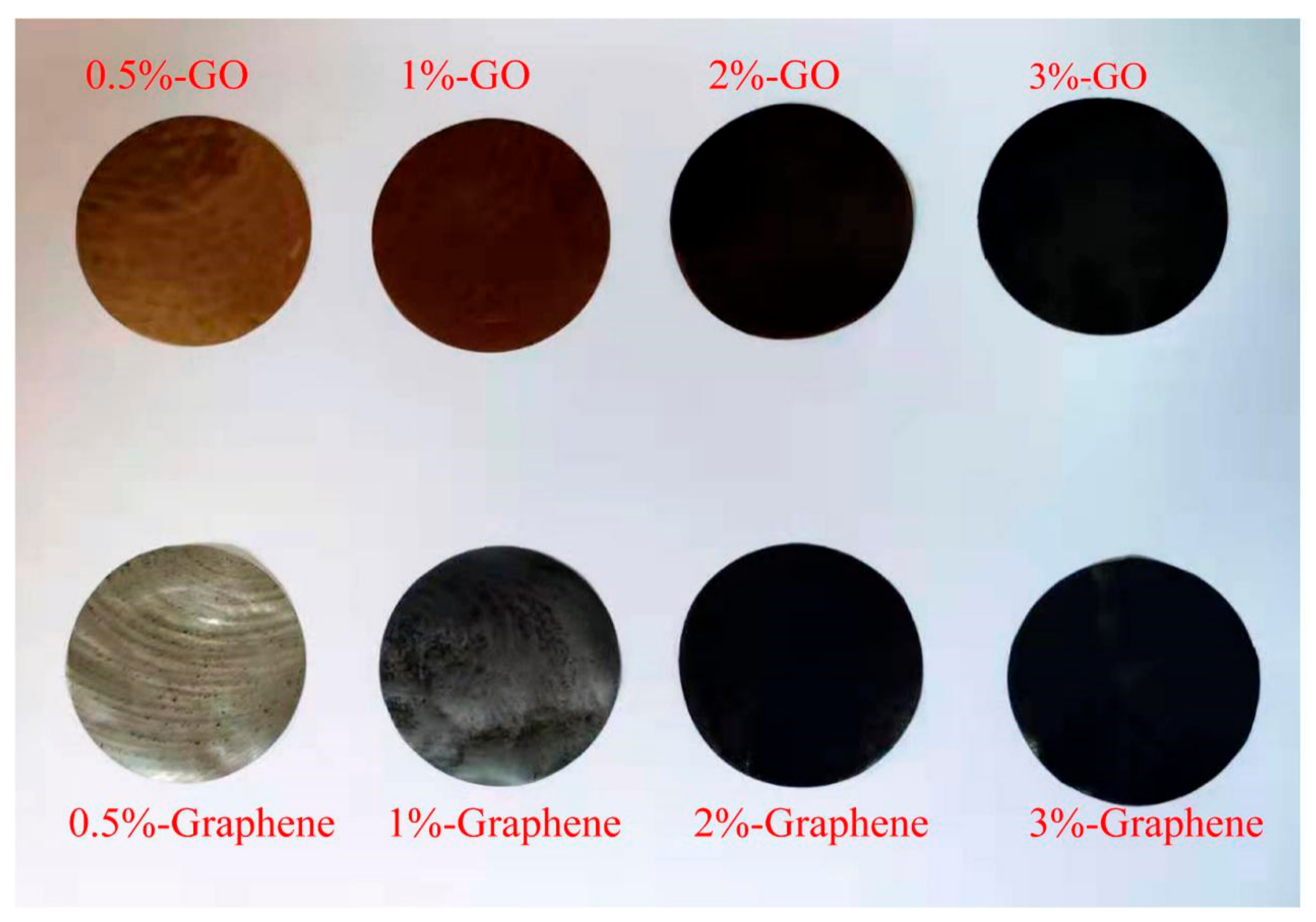
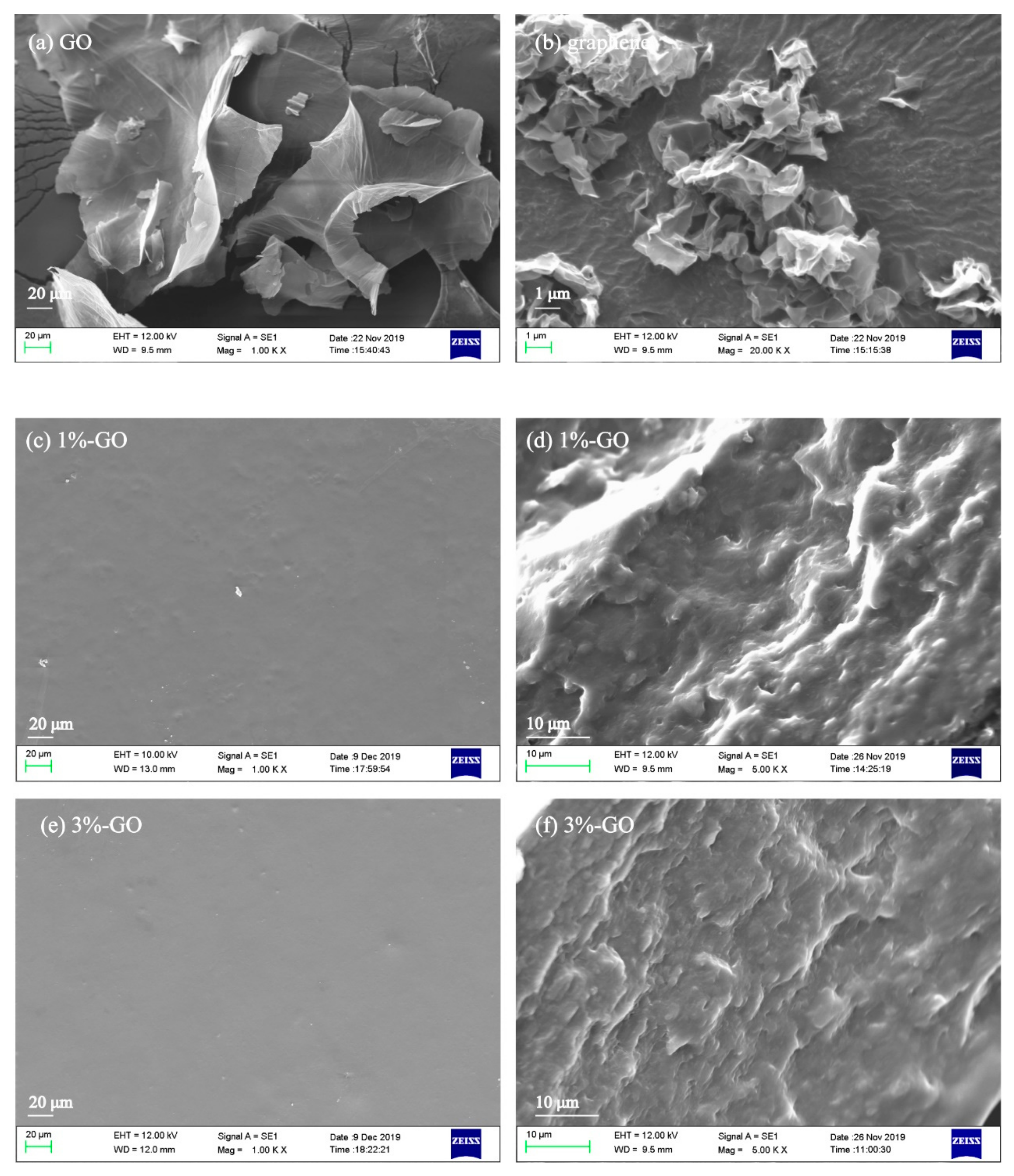
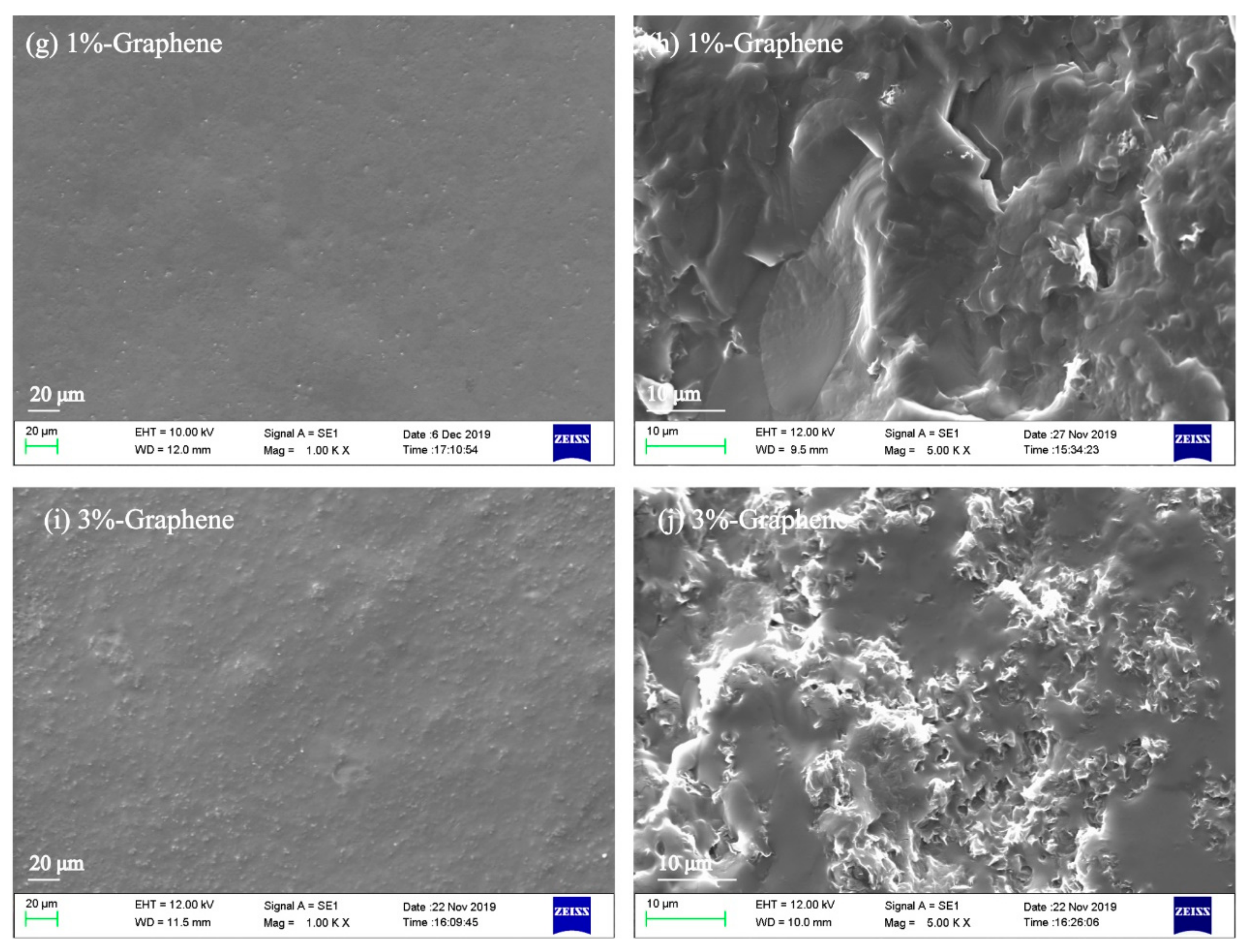
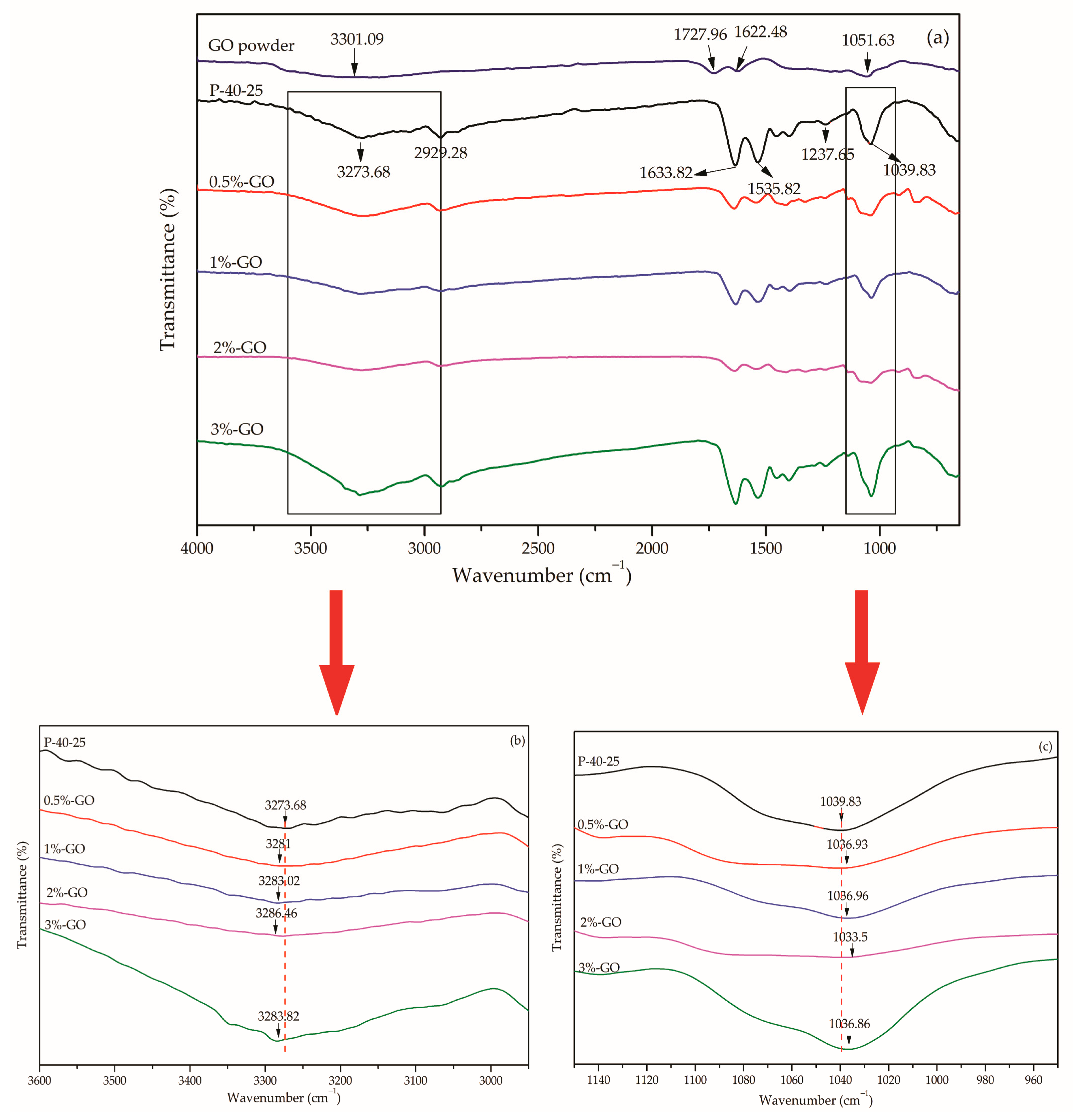
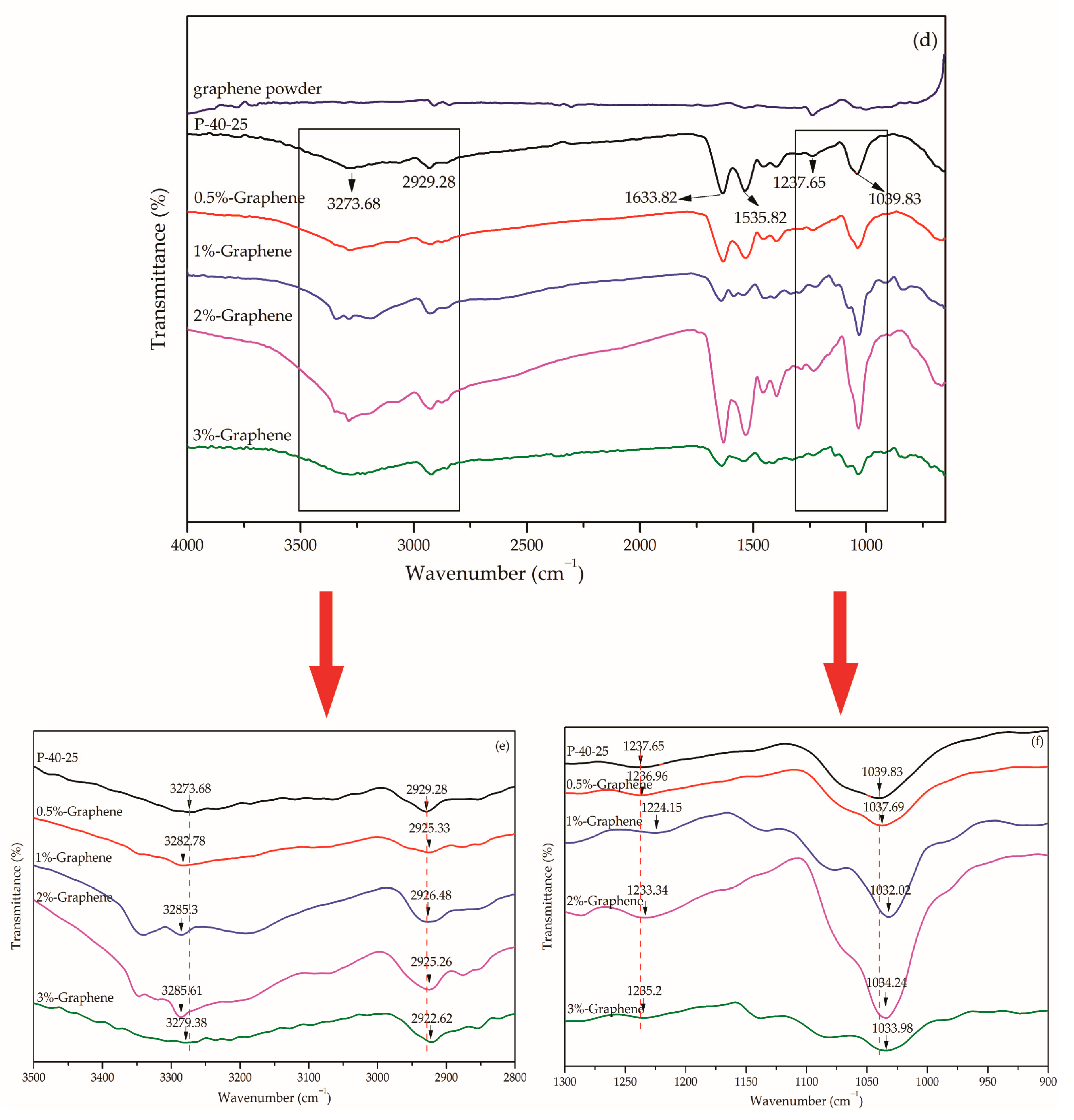



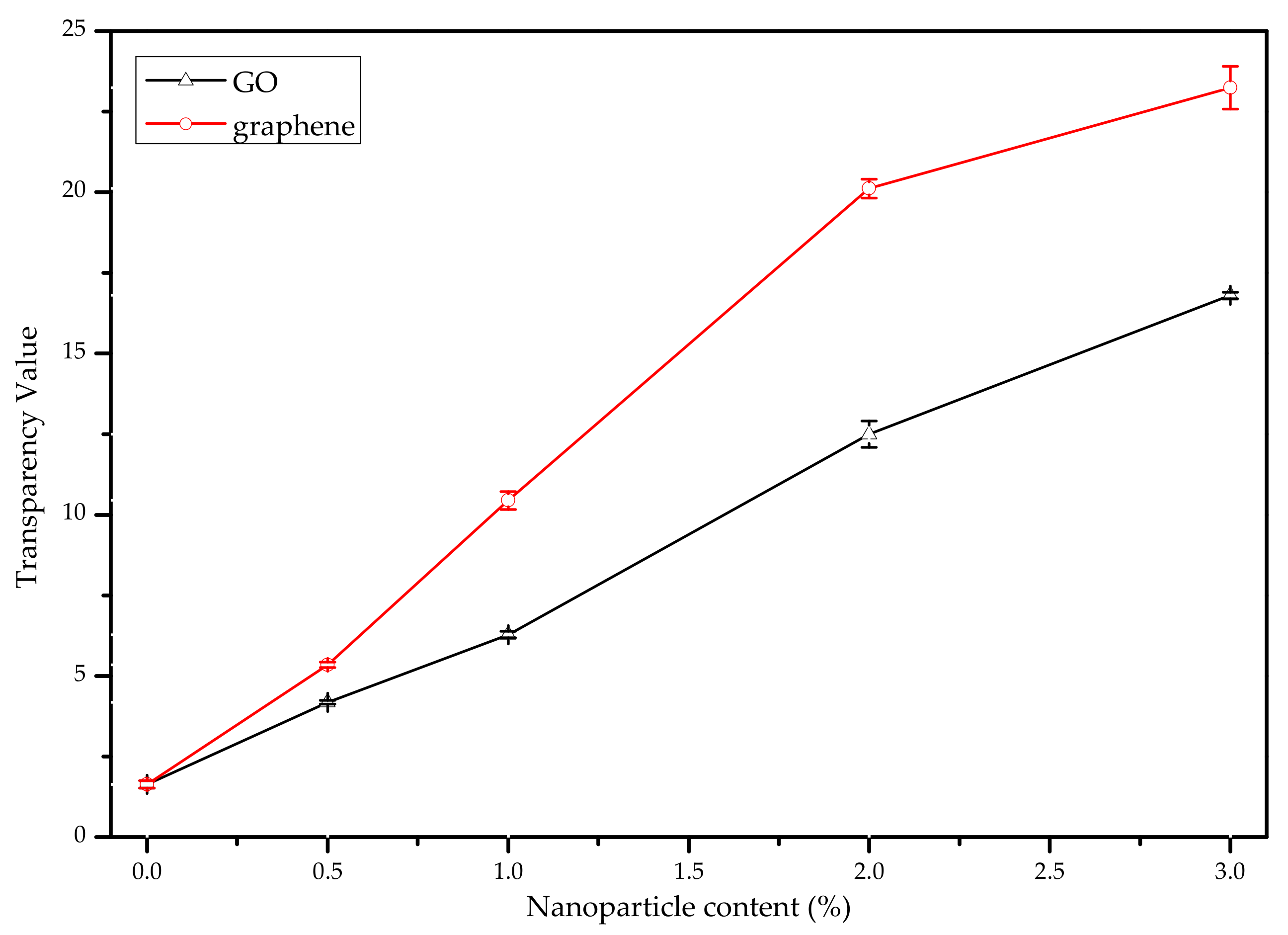
| Sample | FK Powder (g) | 6% PVA (g) | 6% Tris (g) | 0.5% GO (g) | Graphene (g) | H2O (g) |
|---|---|---|---|---|---|---|
| P-40-25 | 1.2 | 13.33 | 8.33 | 0 | 0 | 17.14 |
| 0.5%-GO | 1.2 | 13.33 | 7.33 | 2 | 0 | 16.14 |
| 1%-GO | 1.2 | 13.33 | 6.33 | 4 | 0 | 15.14 |
| 2%-GO | 1.2 | 13.33 | 4.33 | 8 | 0 | 13.14 |
| 3%-GO | 1.2 | 13.33 | 2.33 | 12 | 0 | 11.14 |
| 0.5%-Graphene | 1.2 | 13.33 | 8.33 | 0 | 0.01 | 17.13 |
| 1%-Graphene | 1.2 | 13.33 | 8.33 | 0 | 0.02 | 17.12 |
| 2%-Graphene | 1.2 | 13.33 | 8.33 | 0 | 0.04 | 17.1 |
| 3%-Graphene | 1.2 | 13.33 | 8.33 | 0 | 0.06 | 17.08 |
| Sample | △1 | △2 | Residue (%) | |
|---|---|---|---|---|
| Td1 (°C) | Tonset (°C) | Tmax (°C) | ||
| P-40-25 | 167.5 | 214.83 | 329.33 | 8.75 |
| 0.5%-GO | 200.33 | 229 | 331.33 | 7.77 |
| 1%-GO | 203 | 230 | 331.17 | 11.74 |
| 2%-GO | 199.33 | 231.5 | 329.33 | 12.18 |
| 3%-GO | 200 | 231.83 | 328.83 | 12.37 |
| 0.5%-Graphene | 187.83 | 234.17 | 328.83 | 12.4 |
| 1%-Graphene | 191.67 | 230.67 | 329.5 | 10.08 |
| 2%-Graphene | 195.17 | 230.67 | 330.67 | 11.45 |
| 3%-Graphene | 194.17 | 229.33 | 329.17 | 12.11 |
| Sample | Elastic Modulus (MPa) | Elongation at Break (%) | Tensile Strength (MPa) | Thickness (mm) |
|---|---|---|---|---|
| P-40-25 | 416.78 ± 17.34 | 10.83 ± 1.01 | 9.58 ± 0.37 | 0.087 ± 0.004 |
| 0.5%-GO | 417.73 ± 16.57 | 10.58 ± 1.06 | 9.79 ± 0.29 | 0.0956 ± 0.008 |
| 1%-GO | 425.72 ± 7.97 | 6.92 ± 0.34 | 10.00 ± 0.44 | 0.0905 ± 0.006 |
| 2%-GO | 570.81 ± 12.08 | 4.5 ± 0.4 | 12.96 ± 0.22 | 0.0967 ± 0.007 |
| 3%-GO | 677.69 ± 8.73 | 2.5 ± 0.22 | 14.74 ± 0.32 | 0.0956 ± 0.003 |
| 0.5%-Graphene | 419.76 ± 15.94 | 11.62 ± 0.85 | 10.07 ± 0.31 | 0.0892 ± 0.008 |
| 1%-Graphene | 426.76 ± 11.69 | 9.65 ± 0.88 | 10.55 ± 0.12 | 0.0977 ± 0.016 |
| 2%-Graphene | 485.87 ± 20.3 | 7.78 ± 0.57 | 10.93 ± 0.32 | 0.0939 ± 0.007 |
| 3%-Graphene | 628.47 ± 12.25 | 4.41 ± 0.16 | 11.1 ± 0.31 | 0.0861 ± 0.004 |
| Sample | %T | ||||||||
|---|---|---|---|---|---|---|---|---|---|
| 800 nm | 700 nm | 600 nm | 500 nm | 400 nm | 350 nm | 300 nm | 280 nm | 200 nm | |
| P-40-25 | 79.65 | 77.57 | 74.21 | 66.73 | 41.49 | 18.40 | 0.67 | 0.10 | 0.00 |
| 0.5%-GO | 61.43 | 54.04 | 44.20 | 30.73 | 11.76 | 4.60 | 0.45 | 0.00 | 0.00 |
| 1%-GO | 45.00 | 34.38 | 22.39 | 10.35 | 1.60 | 0.27 | 0.00 | 0.00 | 0.00 |
| 2%-GO | 23.29 | 13.51 | 5.69 | 1.24 | 0.04 | 0.00 | 0.00 | 0.00 | 0.00 |
| 3%-GO | 16.69 | 8.42 | 2.89 | 0.46 | 0.02 | 0.00 | 0.00 | 0.00 | 0.00 |
| 0.5%-Graphene | 36.66 | 34.80 | 32.15 | 27.47 | 15.12 | 7.75 | 0.59 | 0.00 | 0.00 |
| 1%-Graphene | 15.19 | 14.46 | 13.43 | 11.62 | 6.93 | 4.01 | 0.35 | 0.00 | 0.00 |
| 2%-Graphene | 1.97 | 1.84 | 1.66 | 1.37 | 0.73 | 0.38 | 0.00 | 0.00 | 0.00 |
| 3%-Graphene | 1.08 | 1.04 | 0.95 | 0.79 | 0.41 | 0.25 | 0.00 | 0.00 | 0.00 |
© 2020 by the authors. Licensee MDPI, Basel, Switzerland. This article is an open access article distributed under the terms and conditions of the Creative Commons Attribution (CC BY) license (http://creativecommons.org/licenses/by/4.0/).
Share and Cite
Wu, S.; Chen, X.; Li, T.; Cui, Y.; Yi, M.; Ge, J.; Yin, G.; Li, X.; He, M. Improving the Performance of Feather Keratin/Polyvinyl Alcohol/Tris(hydroxymethyl)Aminomethane Nanocomposite Films by Incorporating Graphene Oxide or Graphene. Nanomaterials 2020, 10, 327. https://doi.org/10.3390/nano10020327
Wu S, Chen X, Li T, Cui Y, Yi M, Ge J, Yin G, Li X, He M. Improving the Performance of Feather Keratin/Polyvinyl Alcohol/Tris(hydroxymethyl)Aminomethane Nanocomposite Films by Incorporating Graphene Oxide or Graphene. Nanomaterials. 2020; 10(2):327. https://doi.org/10.3390/nano10020327
Chicago/Turabian StyleWu, Shufang, Xunjun Chen, Tiehu Li, Yingde Cui, Minghao Yi, Jianfang Ge, Guoqiang Yin, Xinming Li, and Ming He. 2020. "Improving the Performance of Feather Keratin/Polyvinyl Alcohol/Tris(hydroxymethyl)Aminomethane Nanocomposite Films by Incorporating Graphene Oxide or Graphene" Nanomaterials 10, no. 2: 327. https://doi.org/10.3390/nano10020327
APA StyleWu, S., Chen, X., Li, T., Cui, Y., Yi, M., Ge, J., Yin, G., Li, X., & He, M. (2020). Improving the Performance of Feather Keratin/Polyvinyl Alcohol/Tris(hydroxymethyl)Aminomethane Nanocomposite Films by Incorporating Graphene Oxide or Graphene. Nanomaterials, 10(2), 327. https://doi.org/10.3390/nano10020327





